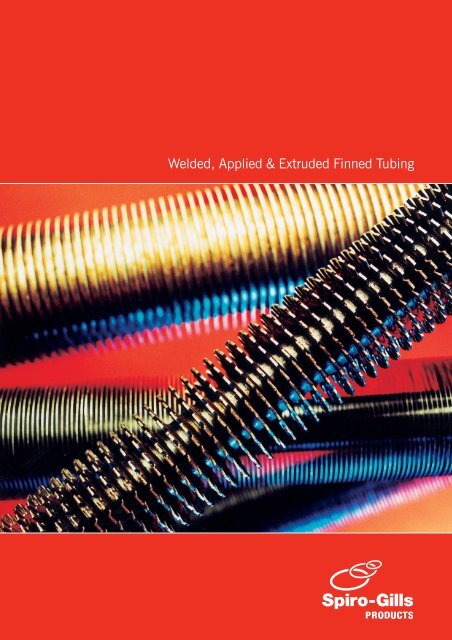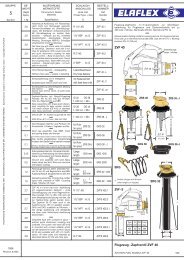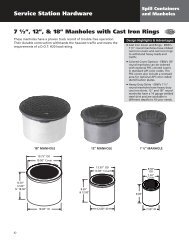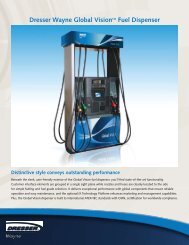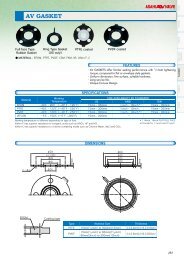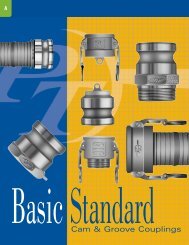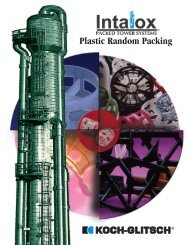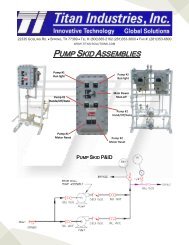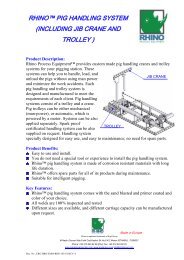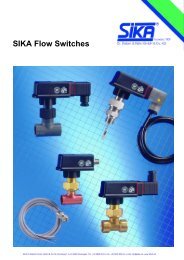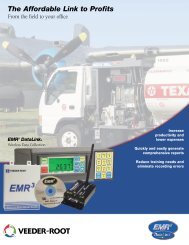SPIRO GILLS Products Brochure - L.B.L Trading Ltd.
SPIRO GILLS Products Brochure - L.B.L Trading Ltd.
SPIRO GILLS Products Brochure - L.B.L Trading Ltd.
- No tags were found...
You also want an ePaper? Increase the reach of your titles
YUMPU automatically turns print PDFs into web optimized ePapers that Google loves.
Welded, Applied & Extruded Finned Tubing
Our company was formed as Spiro-Gills <strong>Ltd</strong> in 1945 tomanufacture finned tubing and finned tube heat exchangers.Spiro-Gills <strong>Products</strong> <strong>Ltd</strong> totally restructured its business in 2004 following its buy-out from GEA.The only UK Company to manufacture Welded, Applied and Extruded Finned Tubes, Spiro-Gills has the abilityto manufacture high-specification tube from 25mm to 219mm diameter for uses in Process/Engine Coolers,Boilers and Furnaces.We consider no job too small or too large – every job is valued and treated with the same respect.Our purpose-built manufacturing facility at Stafford, at the heart of the UK’s motorway network, is constantlyevolving. Specialised infrastructure has been streamlined to provide a faster and more efficient service toguarantee delivery of quality-controlled product on time, every time.The Company’s mission is to exceed customer expectation – and we are dedicated to achieving this throughongoing review and development of our processes. Our reputation is built on the experience of close workingrelationships with our clients across the world, understanding their specific requirements and ensuring thatwe never disappoint. It is a reputation of which we are proud and one which we aim to build upon as ournetworks expand.Using Spiro-Gills to manufacture your finned tubes will guarantee that youreceive a high-quality product, delivered on time at a highly-competitive price.3
Welded Finning Machine4
WELDED FIN TUBESpiro-Gills <strong>Products</strong> is the UK’s largest manufacturer of extended surface tubing. Our welded finned tubingis found all over the world in a wide range of applications. The major uses for welded finned tubes are inheat recovery associated with boilers, gas turbines for power generation and in furnace applications for thepetrochemical industry.Our finned tubes are helically wound using specialised high-frequency welding techniques and may haveplain or serrated fin types. We have vast expertise and more than 50 years’ experience in this field. We originallyproduced finned tubes as Spiro-Gills <strong>Ltd</strong> in 1945 and have manufactured welded fin tubes since 1964 whenthe process was introduced.Our equipment now operates in more than one hundred countries worldwide.Our pre-eminence in this kind of work enables us to offer customers:• Short lead times• An extensive range of material combinations for customised applications• Exceptional quality standards5
PRODUCT SPECIFICATIONOur machines are capable of handling tube/pipe sizes from 25mm o/d to 219mm o/d in carbon, alloy and stainless steels,as well as high nickel alloys. Fin sizes range from 6mm to 38mm high and from 1mm to 3mm thick in carbon steel,stainless steels (300 and 400 series) and high nickel alloys. Serrated fins are available in 4.5mm and 8mm segment widths.QUALITYThe Spiro-Gills name is a guarantee of high standards, and we implement quality assurance management toBS EN–ISO9001:2000. We supply welded finned tubes in accordance with the international standard for dimensions,tolerances and test of HF resistance welded fins. We are a founder member of the international committee which producedthis standard. We have also supported the setting up of an ASTM standard for HF-welded finned tubes. Spiro-Gills notonly works within all international quality standards, in many cases it established those standards through its ownquality leadership.CERTIFICATIONTube/pipe materials can be supplied with certificates according to BS EN–ISO10204.3.1A, B or C. Fin materials can besupplied with certification according to BS EN–ISO10204.2.2.CORROSION PROTECTIONIf required, the external surfaces of finned tubes can be treated with corrosion-resistant fluids.WORLDWIDE AVAILABILITYWe despatch tubes throughout the world by road, rail, container or ship, and can offer a full export packing service on request.AN EXCEPTIONAL SERVICEIn addition to manufacturing extended surface tubing, our sister company Spiro-Gills <strong>Ltd</strong> can incorporate it into the heatrecovery system and supply it as a complete unit. As with our tube manufacturing processes, they work to recognisedBS and ASME quality standards, employing highly-skilled certified welders and operating to stringent guidelines.We believe the expertise and experience available to Spiro-Gills <strong>Products</strong> & Spiro-Gills <strong>Ltd</strong> in this field are unique,and are confident that major operators will find this a quite exceptional service.6
EXPERTISE IN KEY PROCESSESThe processes involved in creating high frequency resistancewelded finned tubing raise a number of interesting technicaldemands to which we bring highly specialist expertise andlong experience of this kind of work.Maximum resistance and therefore maximum heating occur atthe interface between the fin and the tube. Pressure is appliedby various forms of tooling to forge the fin and the tube togetherat the point of maximum heating.For the benefit and interest of plant operators, we outlinebelow some of the issues involved in:• Resistance welding• Weld quality• Minimising pressure dropRESISTANCE WELDINGHigh-frequency resistance welding usually employs a currentof 450,000 Hz. With this technique, the fin is edge woundencircling the tube to give a continuous weld.The forming of the fin around the tube and the heat of weldingcauses some upsetting or widening of the base of the fin,resulting in a contact area wider than the fin itself.Here again, the function of the weld is to maintain the contactbetween the fin and the tube. Heat is thus transferred across thewhole interface and not just through the weld itself. However,the quality of the HF weld is more important in maintainingnegligible resistance to heat transfer between the fin and tube.The resistance welding process produces a strong metallurgicalbond between the fin and the tube while minimising the heataffectedzone (HAZ) in the tube.The use of pressure to forge the fin and the tube together helps tominimise the heat input necessary to make the weld. In addition,the HF process allows the whole weld area to be continuouslywater-drenched which keeps the tube cool, except in the immediatearea of the weld.As a result, most common tube materials show little change ingrain structure or physical properties when fins are welded to them.The most notable exceptions to this are the 3% to 9% chromiumsteels which change from a ferritic to a martensitic microstructurein the heat-affected zone, with a significant increase in hardness.The use of high-frequency current results in very localisedheating of the tube surface and the edge of the fin. This skineffect produces higher weld speeds and greater ease in weldingdifficult material combinations.The HF process also allows much thicker fins to be welded.In fact, it is now possible to weld fins heavy enough to replacethose previously available only with MIG, TIG and stud-weldingprocesses, which are generally more expensive and requirepost-weld heat treating.The diagram above is a hardness study for a 9% chromium steeltube with HF-welded fins. The heat-affected depth is minimalwhen compared with other types of welding.The HF process involves the use of heat and pressure to obtaincoalescence of the fin and tube. An electric current is applied bycontacts on the fin and tube, and the resistance in this circuitproduces the heat necessary for welding.Post-weld heat treatment of HF-welded fins is not considerednecessary for satisfactory service, even in the extreme caseshown above, because of the superficial nature of the changesin the microstructure.8
WELD QUALITYThe welding of fins to tubes is now easier and faster thanksto the use of the high-frequency resistance welding process.However, operator skill and knowhow are still vital to produceconsistently superior welds in the many different materialsrequired by the power, chemical and petroleum industries.MINIMISING PRESSURE DROPThe manner in which the fin is formed around the tube canhave a significant effect on the pressure drop of the fluid flowingthrough the fins.To minimise pressure drop, the fin must be perpendicular to thetube, and corrugation at the base of the fin must be controlled.In determining the quality of a weld by superficial examination,several elements should be noted.In order to achieve fusion using a resistance welding process,the oxide layer on the tube and the fin must be displaced fromthe weld area, and this usually appears in the form of expulsionalong both edges of the fin. It is difficult to achieve a satisfactoryweld with no expulsion.Corrugation at the base of the fin can also result in poor weldquality, and for this reason weld area tooling must be designedto minimise corrugation.Standards vary widely regarding the deviation of the fin froma perpendicular position. The more the fin is allowed to lean,the more the free-flow area is blocked and the pressuredrop increased.Corrugation at the base of the fin causes similar effects, andmust be minimised for best performance. In geometries whereit is difficult to control corrugation, serrated fins should beconsidered, since this is not a problem with segmented fins.Where weld quality is of utmost importance, serrated types offins should be considered, since many welding problemsassociated with forming plain fins around the tube are eliminatedby using a segmented fin.The only UK Company to manufacture Welded, Applied and Extruded Finned Tubes,Spiro-Gills has the ability to manufacture high-specification tube from 25mm to219mm diameter for uses in Process/Engine Coolers, Boilers and Furnaces.9
APPLIED & EXTRUDED FIN TUBESpiro-Gills <strong>Products</strong> <strong>Ltd</strong> is the UK’s premier manufacturer of Finned Tubes for air-cooled heat exchangers.Because good quality cooling water is either too costly or unavailable, such exchangers are relied upon heavilyby most process and power generation plants throughout the world.The heart of the air-cooled heat exchanger is the extended surface – the section where heat is transferred.This surface is composed of helical high-finned tubes which need to be replaced from time to time due to corrosion,fouling or damage – either to the fins or to the base material.Finned tubes are supplied in either applied or extruded form. Their differences are detailed in the following pages.We can supply replacement finned tubes to suit your planned shutdowns or for emergency use.Extruded Finning Machine
Applied Finning Machine11
EXTRUDED FINSSG-K Fin(Knurled L Fin)Application: Standard finfor medium-temperatureapplications, giving increasedatmospheric corrosionprotection to the outersurface of the base tubeUpper limiting temperature:250°CManufacture: Fin foot ispre-formed into an L shapeand applied to base tube undertension. Knurling tools bothprecede and follow the layingdown of the fin foot so that thefin material is locked into thepre-knurled tube. This gives upto 50% greater thermal contactarea than standard L fin andalso ensures an airtight fin totube bond, resulting in greatertube protectionFin materials: AluminiumBase tube materials:Any metallic materialStandard dimensionsof applied fin tubes:Base tube dia. (mm):25.4, 31.8, 38.1, 50.5, 50.8Fin height (mm):9.5, 12.7, 15.88Fin pitch:236 to 433 fins/metreSG-Extruded Fin(Bi-metallic Fin)Application: High-efficiencyfins for higher temperatureapplications giving completeand permanent atmosphericcorrosion protection of the basetube. Using over 40% morealuminium than the equivalentapplied fin, the extended fin isvery robust and resistant tomechanical damage, allowingthe finned tubes to be cleanedwithout damage using eithersteam or high-pressure waterUpper limiting temperature:300°CManufacture: A carefullydegreased core tube is fitted intoan aluminium primary tube.This assembly is then fed intothe triple-spindle finning headof the fin-extruding machine.Three special multi-disc packsextrude the aluminium tube intohelical high fins while reducingthe inner diameter to give firmpressure contact with the core tubeFin materials: AluminiumBase tube materials:Any metallic materialStandard dimensionsof extruded fin tubes:Base tube dia. (mm):25.0, 25.4, 31.8, 38.1Fin height (mm):15.88Fin pitch:354, 393, 433 fins/metre13
TYPICAL APPLICATIONSThe wide range of uses for helical high-finned tubes includes:• Steam condensers• Oil coolers• Air pre-heaters• Product coolers – gas, chemicals, petrochemicals, oil etc• Overhead condensers• Water coolersOur McElroy finning machines are recognised as the most efficient and reliable for the manufacture of applied finned tubes.Using Spiro-Gills to manufacture your finned tubes will guarantee that you receivea high-quality product, delivered on time at a highly-competitive price.14


